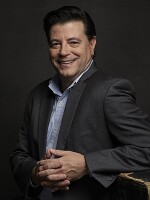For years, Twain scholars have been fascinated with George Griffin. Born enslaved, many believe Griffin’s calm demeanor and intelligence was the inspiration for Jim, the resourceful runaway enslaved man in Twain’s “Adventures of Huckleberry Finn.”
A photograph of Griffin was discovered recently. It is the only known picture of the man, who was also a prominent leader in Hartford’s Black community, serving as deacon of Hartford’s Metropolitan African Methodist Episcopal Zion Church.
“Griffin was a smart man with incredible social skills,” said Twain scholar Kevin Mac Donnell, who discovered the photograph. “He had both street smarts and he was intelligent. He was probably self taught to read and write.”
Mac Donnell said Griffin’s influence at the Mark Twain House went beyond the typical duties of a butler, calling him a “factotum, and jack-of-all-trades.” That included covering for Twain when he wasn’t in the mood to receive guests.
“He'd go and announce the visitor to Twain and Twain would say, ‘I wouldn't go down and see that guy even if it was one of the 12 apostles!’— he actually said that once,” Mac Donnell said. “George Griffin went down and very gently broke the news. ‘Mr. Twain is not available right now. And he'd love to see you.’ He had a really good faculty for sending people away without hurting their feelings.”

While Twain’s wife Olivia grew up in a well-to-do household with a staff, Twain did not, and was not familiar with the customary distance maintained between family and staff. As such, Griffin became an important friend and confidant to Twain.
“There was real camaraderie, real playfulness,” Mac Donnell said. “I think the best sense you get of Twain's relationship with George Griffin is the way that Twain writes about him in a piece called “A Family Sketch,” and he devoted about one-third of that manuscript to George Griffin.”
In other writings, Twain describes Griffin as “handsome” and “well built,” but until recently no one knew for sure what Griffin looked like. In December, Mac Donnell was notified of an ebay listing for a stereoscope image of a Black man dressed in a tuxedo, sitting on the porch of Twain’s House, with three house staff members. Mac Donnell obtained the photograph, and is convinced it’s Griffin.
“He is dressed in a coat and tails, peak lapels, a white collar, and he has spats. And he's sitting on the ombra at the Mark Twain house, which kind of gives it away,” Mac Donnell said. “Plus the fact that Mark Twain only had one Black butler that ever worked for him. And the photograph can be clearly dated to the summer of 1875. There's both documentary and circumstantial evidence that identifies the photograph from 1875. George Griffin was Twain’s butler in '75.”
The picture was unveiled at The Mark Twain House and Museum Tuesday night. Kevin Mac Donnell has written a biography of George Griffin for the Mark Twain Journal, “George Griffin: Meeting Mark Twain's Butler Face-To-Face.”


